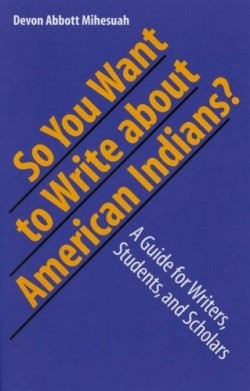So You Want to Write about American Indians?
A Guide for Writers Students and Scholars
This comprehensive guide to writing about American Indians assists both novice and experienced writers who seek to write responsibly and engagingly about America’s first peoples. Beginning with the title, this candid discussion addresses important, complex questions for writers to explore before writing about American Indians. Writers should identify whether they are writing for love or money, what they know, what time period they are writing about, what type of book they will write, and who will read it. Thinking through the possible answers to these guide questions not only helps to start the writing process, but also ensures accuracy, whether the book will be fiction or non-fiction.
In addition to its instructional slant, the book debunks common stereotypes about American Indians, to help would-be writers avoid falling into formulaic, uninformed prose—something that occurs all too often in work about American Indians. For example, Mihesuah includes a chapter on Stereotypes and Other Mistakes, which provides an overview of common images that have no basis in fact. After clarifying the misinformation, Mihesuah provides an historically accurate account of the numerous matriarchal Native societies, addresses the significance of the oral tradition in many tribes, explains the tremendous loss to disease that many tribes endured, and acknowledges Natives’ countless and varied contributions.
The text is exceptionally informative, and the author’s extensive credentials add credibility to her voice. Mihesuah, a Choctaw herself, has written nine books and dozens of essays, edited four volumes about Natives, and served as editor of the prestigious American Indian Quarterly. In addition, she currently serves as editor of a new book series from University of Nebraska Press, Contemporary Indigenous Issues.
Most impressive about this text is the author’s clarity and information about confusing issues. For example, the terms “American Indian” and “Native” are often used interchangeably. Mihesuah explains that just because a term is recognizable does not mean that it is preferred. Many Natives feel that “American Indian” is “offensive because it is a label assigned by EuroAmericans, not by the people themselves.” She explains what is most acceptable by Natives, not only with regard to terminology but also with regard to traditions and beliefs of different tribes. She also includes resources and references for prospective writers to consult.
The volume also offers concrete strategies to help authors with the writing process. Mihesuah gives directions about how to get started, how to stay focused, and how to complete a writing project—fiction or non-fiction—with Natives as the intended subject. This is both a handy guide and an informative text for readers and writers of Native studies.
Reviewed by
Carla L. Verderame
Disclosure: This article is not an endorsement, but a review. The publisher of this book provided free copies of the book to have their book reviewed by a professional reviewer. No fee was paid by the publisher for this review. Foreword Reviews only recommends books that we love. Foreword Magazine, Inc. is disclosing this in accordance with the Federal Trade Commission’s 16 CFR, Part 255.

